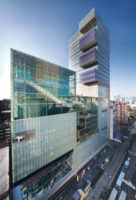The 8.0-magnitude earthquake that rocked central China in 2008 killed 68,000 people and left millions homeless in Sichuan Province. Among the displaced and stricken following the catastrophic quake were countless schoolchildren, like those in the town of Xiaoquan.
In response to the community’s need for a new structurally sound elementary school, Beijing-based Trace Architecture Office (TAO) designed an 8,920-square-meter academic complex of reinforced, poured-in-place concrete and wood. Instead of the local or provincial government, a board of sponsors that included the Red Cross of Jiangsu, a Buddhist temple foundation in Canton, and the business schools of Beijing and Tsinghua universities, commissioned the educational campus. The playfully labyrinthine complex includes three main classroom buildings; multipurpose rooms for music, art, and science education; a dormitory; and a dining hall. A covered outdoor corridor that TAO founding principal Hua Li calls a “spine” connects each of the classroom buildings. The corridor also provides protection from the sun and rain in hot and humid Xiaoquan, while allowing cooling breezes to move through the campus.
“We tried to create a series of urban spaces that enriched the students’ daily experiences with architecture,” Li explains. The new school is built to withstand tremors up to a magnitude 7.0 on the Richter scale.
In order to connect students to a familiar environment, Li says his design team tried to create forms that reference regional architecture in both materials and form. Winding outdoor corridors on the campus mimic Xiaoquan’s traditionally mazelike streets and alleys. Buildings are organized around open courtyards and feature local bamboo, teakwood, and brick sourced from destroyed structures. TAO avoided bright colors and other clichés too often found in elementary school design, and instead allowed the materials they used to take center stage. “We wanted to transform the traditional concept of elementary education,” says Li.
The school’s success is measured not just in test scores and grades, says Li, but in the students’ ability to use the place to “do things they like”—talking, playing, and riding bicycles—activities encouraged by the school’s mazelike spaces. “[School officials] asked students to write essays with feedback about the new school’s architecture,” says Li. “And most students talked about the fun they got from the space,” he adds.









Post a comment to this article
Report Abusive Comment